Odegaard & De Bruyne: Masters of the inside-right channel in very different ways
Stamfordblue 2023-04-27 22:08:43 评论
It would be simplistic to say Mikel Arteta has attempted to replicate Pep Guardiola's Manchester City side since taking charge of Arsenal, but it's not too far off.

There's the emphasis on patient build-up play, the pressing in advanced positions and the use of a 2-3-5 or 3-2-5 in the attacking phase. There's Gabriel Jesus and Oleksandr Zinchenko, too.
But for all Guardiola's tactical acumen and his emphasis on structure, his City side have also depended on individual genius. In particular, the brilliance of Kevin De Bruyne, the side's chief playmaker who can play passes that others can't even spot.
Guardiola's system means De Bruyne usually has multiple targets for his passes, often running in behind the opposition. But it takes technical quality to be able to play those assists. Finding an equivalent of De Bruyne, as much as anything, would be one of Arteta's most difficult tasks at Arsenal.
The Spaniard had two goes at finding his De Bruyne. The first was his former team-mate Mesut Ozil, who was eventually cast aside amid questions about his attitude. But in his early weeks, Arteta tried to find a role for Ozil. Although theoretically fielded as the No 10, in reality, Ozil was positioned almost permanently in the inside-right channel — just like De Bruyne — from where he would attempt to angle balls over the opposition.
(Photo: BEN STANSALL/AFP via Getty Images)
Arteta's faith in Ozil didn't last long and he was frozen out by the start of his first full season in charge. For the first half of that campaign, in part because Arteta often used a 3-4-3 system, Arsenal badly lacked an equivalent. Willian was positioned too far wide, Nicolas Pepe would instinctively shoot rather than pass, Bukayo Saka was often a left-wing-back and Emile Smith Rowe hadn't yet broken into the side. In that period, it was difficult to see what Arsenal were trying to do. There was structure but no imagination. Until, once again, Arsenal solved their creative problems by turning to a Real Madrid cast-off.
Odegaard's first half-season offered promise rather than consistent end product, with a goal or assist once every 289 minutes. That improved to 253 minutes last season and is once every 140 minutes this season. Odegaard isn't quite at De Bruyne levels in terms of creativity, but in terms of impact on his side overall, Arteta can realistically claim to have found an equivalent in that inside-right channel.
One of the obvious differences, though, is that while De Bruyne is right-footed, Odegaard is left-footed. This changes so much about the passes they play into the box — the positions they're struck from, the angle and trajectory of the pass, and how easy they are to convert.
Here's De Bruyne's map of chances created and assists from the Premier League this season. That inside-right channel, the space De Bruyne is regularly positioned in, is denoted in red. And the notable thing about De Bruyne's map, aside from how spread out the passes are, is that the Belgian is constantly charging into the penalty box from his favoured channel — or even wider — and putting in crosses rather than through-balls.
This has become De Bruyne's trademark.
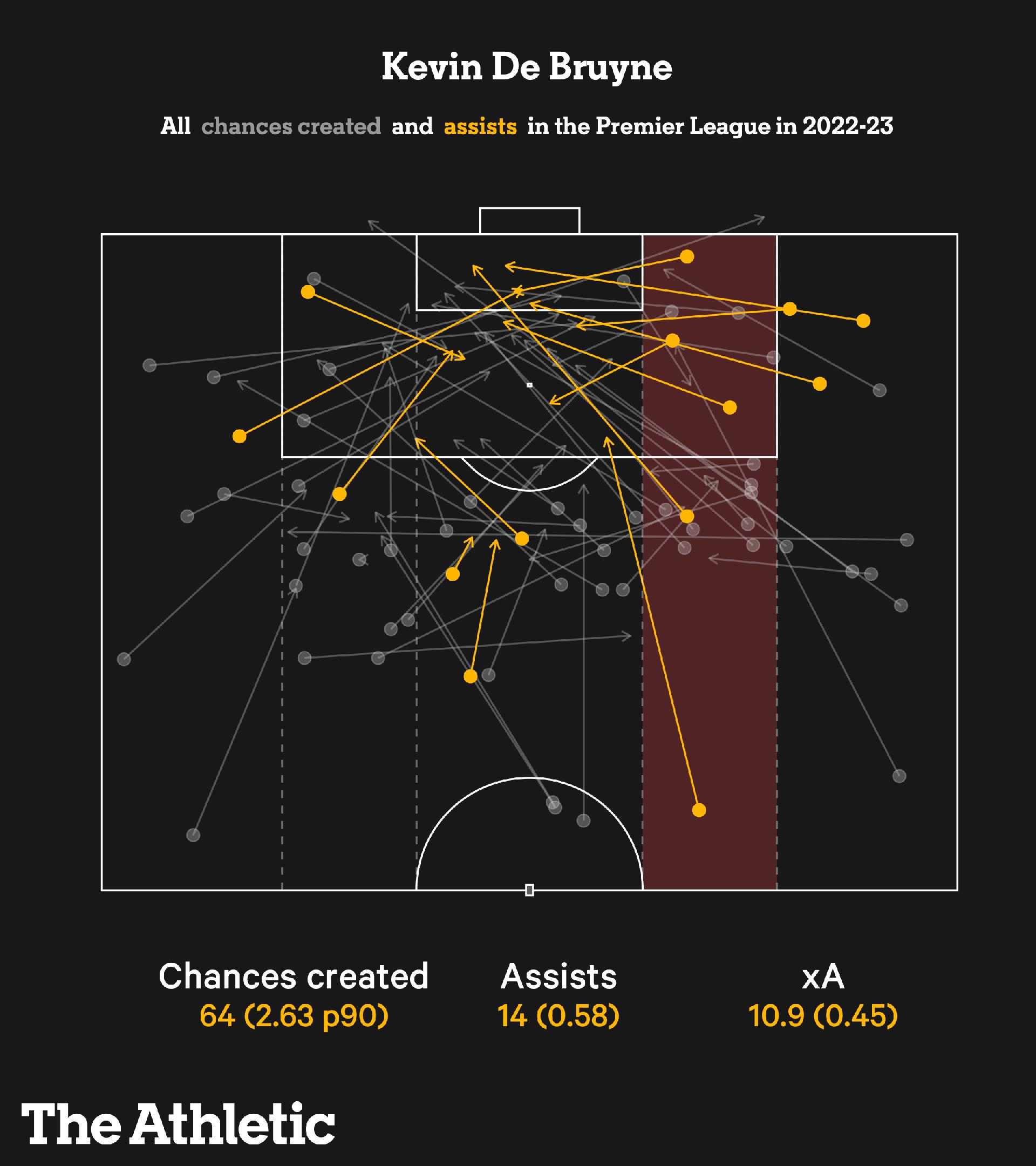
It's difficult to think of another player in football, particularly one who starts from a primarily central position, who has proven so devastating with those balls. And because De Bruyne is playing the ball into a corridor in behind the defence, often towards the far post, he can afford to properly drive the ball at speed.
Often, that means City have more than one attacker capable of getting on the end of the pass because the ball is travelling through multiple points where it might be diverted into the net. This is an assist away at Wolves, for example. And here's a quick quiz: which of the players in the middle — Erling Haaland at the front, Jack Grealish in the middle or Bernardo Silva at the back — turned the ball in?
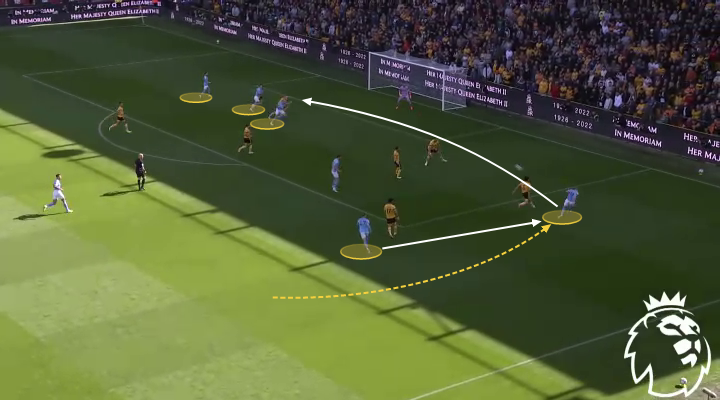
It was the middle of the three, Grealish. De Bruyne might not necessarily have been aiming for him, but simply by getting the angle of his cross right, three different players might have finished the move.
Odegaard generally doesn't have that luxury by virtue of being left-footed. And Odegaard isn't simply left-footed, he's very left-footed. Ninety-three per cent of his Premier League shots — excluding headers — have come with his left foot. Assuming that reflects his level of confidence at creating with his right foot, too, then it's clear Odegaard has less license to push outside from this inside-right role unless he then checks back inside.
Here are Odegaard's chances created and assists this season.
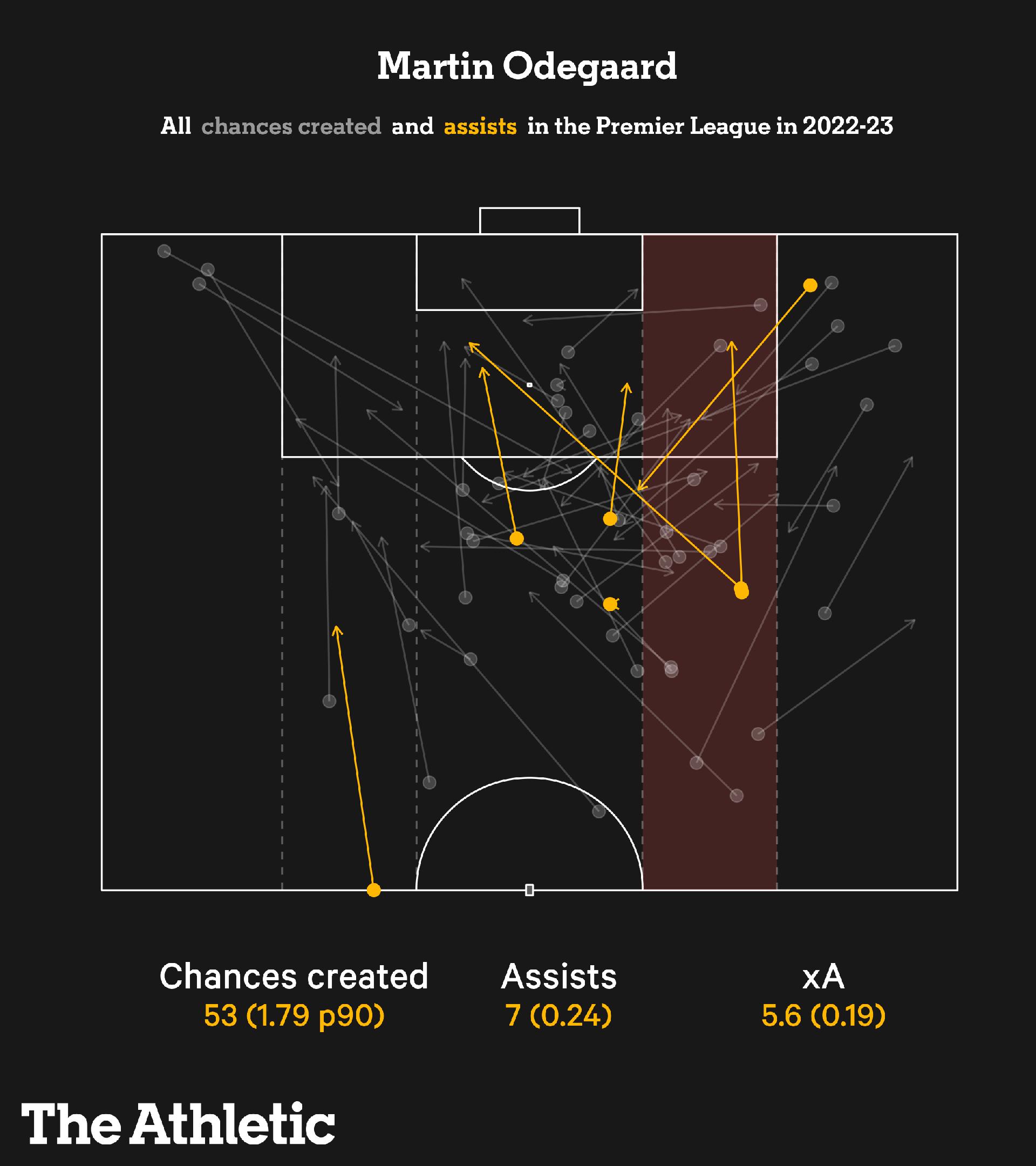
From that inside-right position, with his left foot, Odegaard has to slide the ball more delicately through the defence, such as this assist for Gabriel Martinelli against Liverpool.
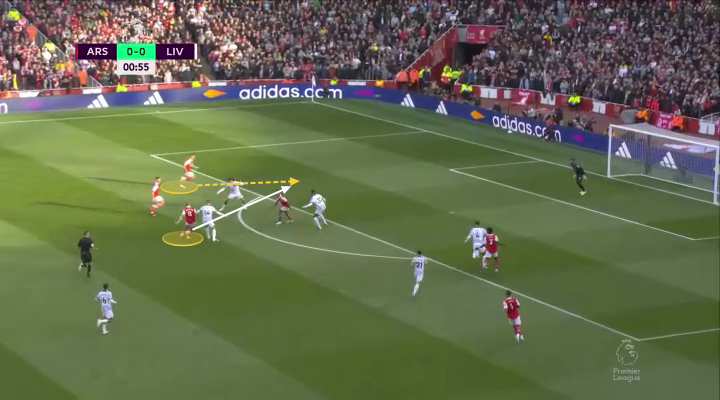
Even then, his passes will generally curl towards the goalkeeper rather than into the striker, so there's little room for error.
Therefore, Odegaard's approach is often more about lofting passes towards the far side. He particularly likes floating balls over to Martinelli or Granit Xhaka, relying on them timing their runs correctly and the ball dropping at the right moment, such as for Xhaka's header against Leeds.
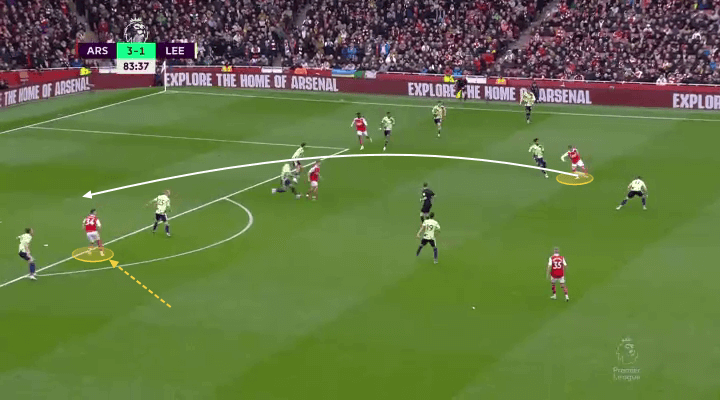
To use a cricket analogy, Odegaard has to be concerned with line and length, whereas De Bruyne, when pushing out wide, can concentrate primarily on line.
Odegaard is also capable of playing the ball out to Bukayo Saka, who has turned difficult situations into goals with his trickery and finishing ability. But it's interesting that Odegaard is yet to assist Gabriel Jesus and has only created seven chances for the Brazilian this season. Jesus' tendency to drop short rather than run in behind and the aforementioned issues with left-footed passes from the inside-right channel means Arsenal's chief playmaker and centre-forward aren't regularly combining.
Perhaps significantly, Odegaard twice assisted goals for Eddie Nketiah, a more straightforward striker, during Jesus' injury layoff. It's worth contrasting Odegaard's lack of assists for Jesus with De Bruyne's eight Premier League assists for Haaland (including set pieces).
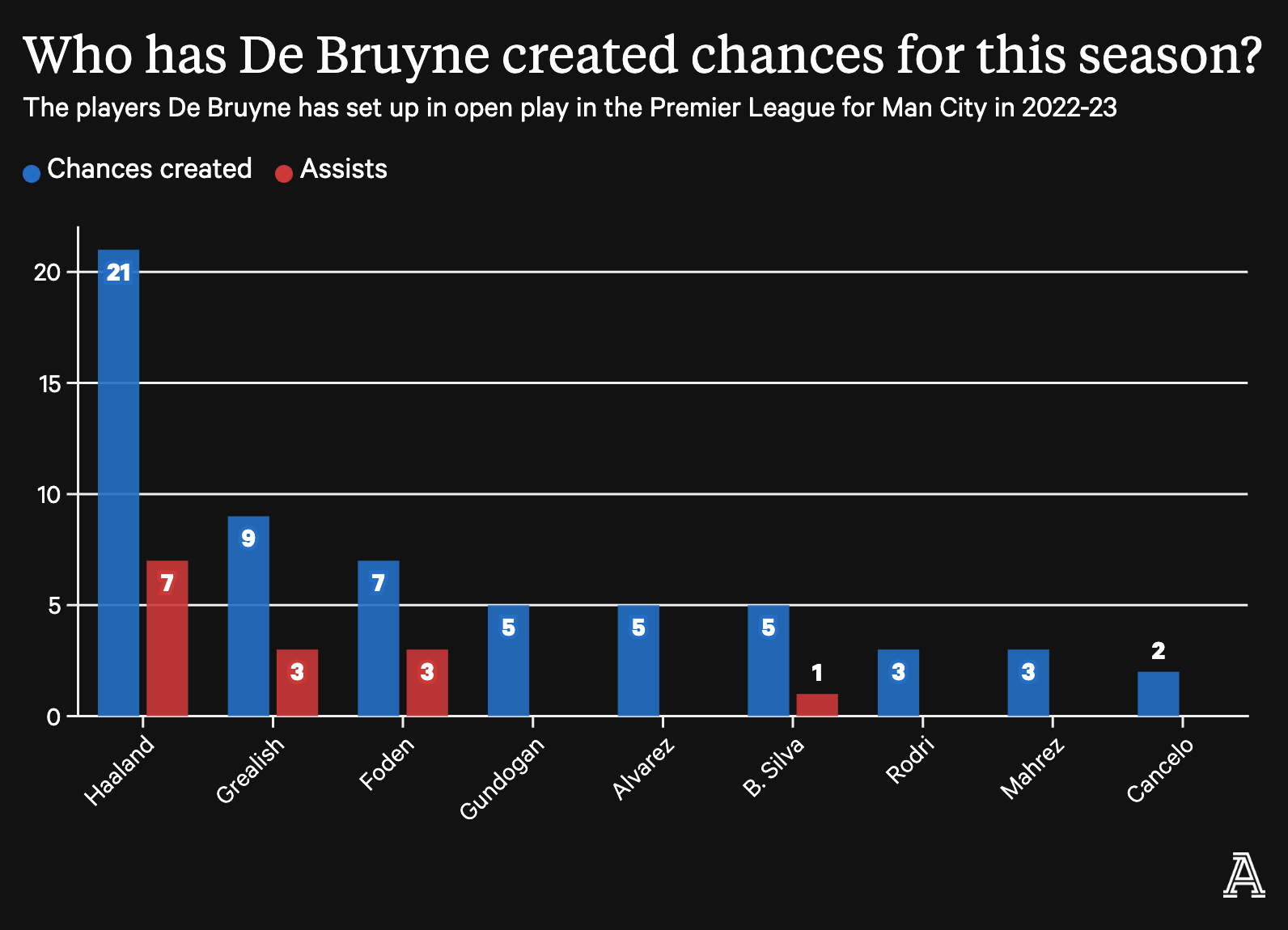
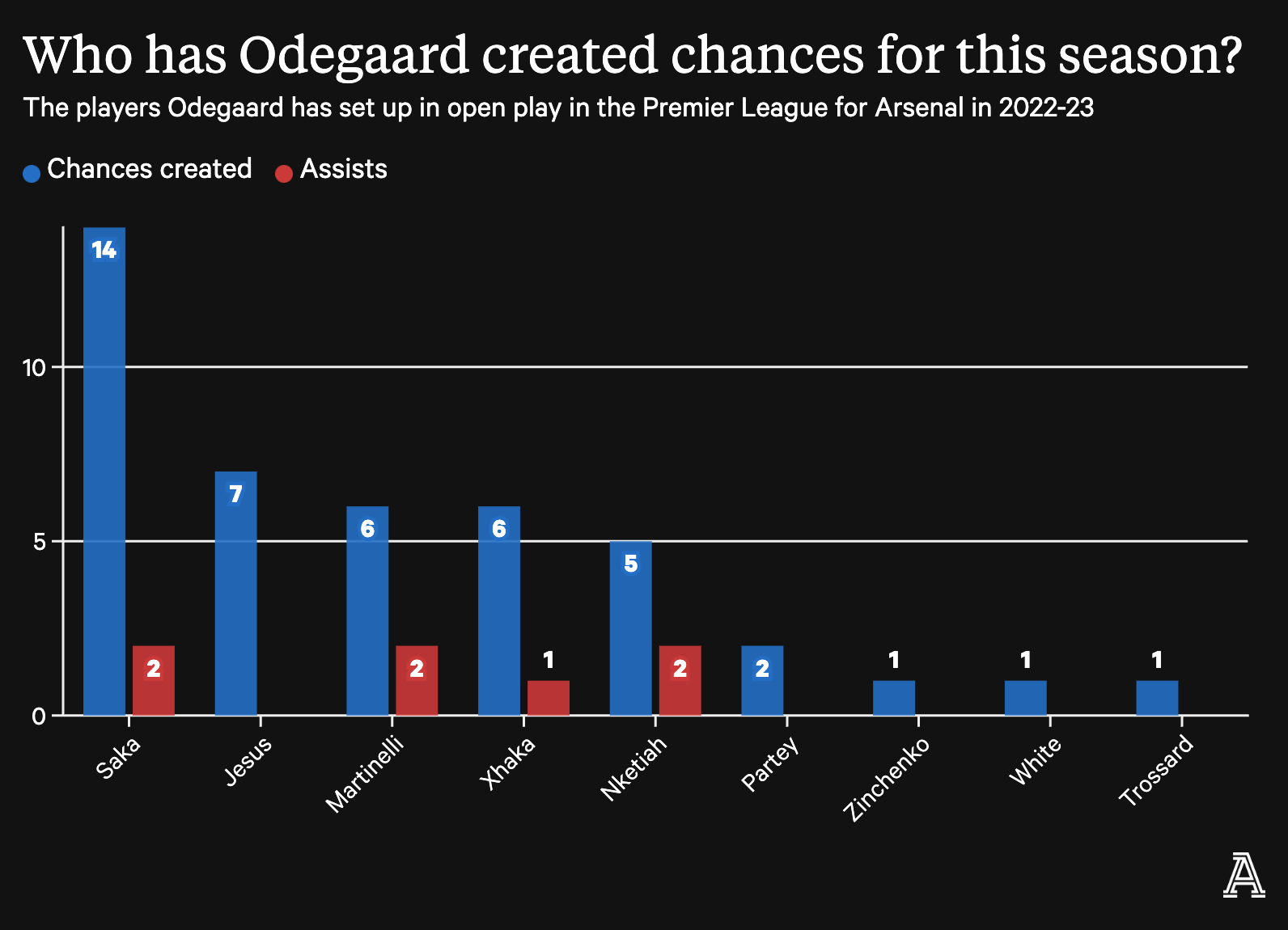
Where Odegaard's left-footedness comes in handy, though, is in terms of goalscoring. The typical thing to consider here is his ability to receive the ball in the channel, cut inside and bend the ball towards the far corner, as he did on Friday night against Southampton.
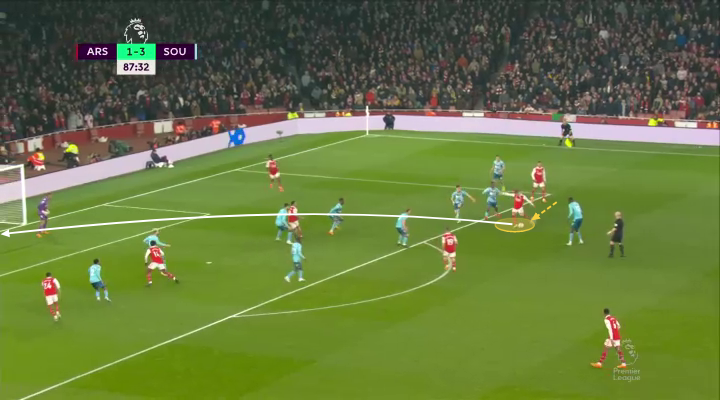
But it's also useful in terms of converting cut-backs from the left, which is a major part of Arsenal's gameplan. Odegaard is particularly adept at suddenly sprinting towards the near post, almost laterally, to receive a pass and finish with his left foot. This generally makes the angle for the pass easier. The best example was possibly a shot eventually turned home by Nketiah, a late winner against Manchester United.

De Bruyne is capable of being a fine goalscorer himself, of course, and is also less reliant on his stronger foot than Odegaard. But having scored 15 league goals last season, he's reverted to being almost a pure assister this season after the arrival of Haaland, managing only five goals to Odegaard's 12.
In part, that's because he is concentrating on that inside-right channel again, having sometimes been unleashed last season in a position that enabled him to shoot more. Of his five goals this season, one was a free kick, another was an opportunistic effort against Arsenal after Takehiro Tomiyasu's wayward pass, and one was this goal against Bournemouth with the outside of his foot. It was a lovely improvised finish but won't be a regular source of goals.
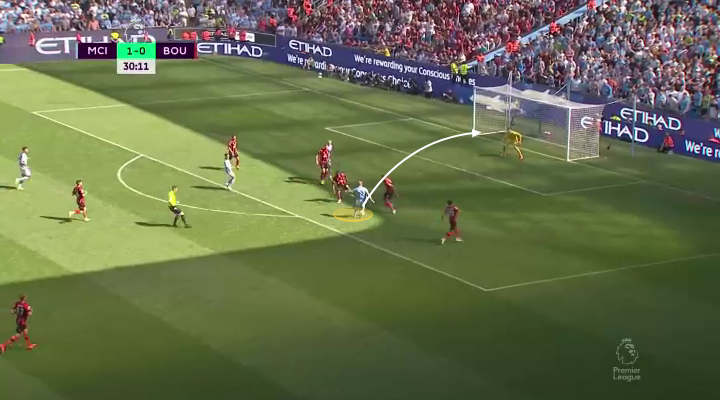
The structure of City and Arsenal is similar, but there are key differences according to personnel. De Bruyne and Odegaard symbolise City and Arsenal neatly – they occupy the same position and have roughly the same task, but they go about things in a very different manner.
De Bruyne, with a goal and an assist, was the dominant player in the reverse game. If Arsenal are to win tonight, Odegaard probably needs to outshine his counterpart.
- 消息参考来源: SN_SPIDER_MANUAL
- 严禁商业机构或公司转载,违者必究;球迷转载请注明来源“懂球帝”
- 懂球帝社区规范:抵制辱骂

